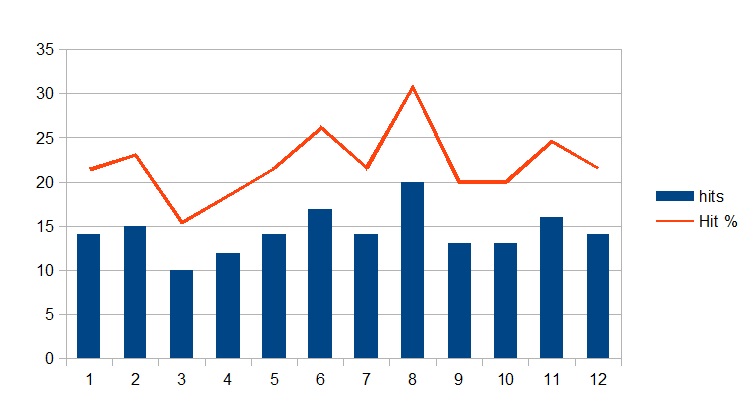Zener Card Diary March 28, 2020.
The most interesting thing to have happened so far in these sessions is changing from the French Tarot deck to the Universal Tarot deck.
Once I had changed to a real Tarot deck the results changed noticeably.
This change didn’t prove ESP. But, the results were enough to make me think that a change in decks caused something.
Science is no doubt a serious discipline. I do not pretend to be a scientist by any means. My education was in fine arts, and some breadth philosophy courses. Therefore, I don’t have the technical experience to practice expert experimentation. However, I do know how to thorough and critical.
I am well-read and understand how to perform an experiment. I try to do all this with rigor.
There is no way to change the middle school science fair vibe. I am ok with that.
With that self-conscious caveat out of the way, let’s keep investigating.
New Investigation
The investigation has changed a bit in the Zener Card diary. It isn’t about getting high hit percentages, it is about seeing what the data does over time. What are the dynamics of the session? What are the oscillations of the data?
Having a handful of tests I can see that it isn’t possible to get a hit percentage above 40 percent. That would be guessing 10 out of 25 Zener cards, or roughly 26 out of 65 cards.
You would have to get 15 hits out of 25, or 39 out of 65 for a 60 percent hit rate. That result would be significant. Those statistics come from the Wikipedia Zener card article. It shows you the historic range of statistics for this test.
No test has even come close to the 60 percent hit percentage. I once got 10 out of 25 (40%) in a private test, and that was the highest out of all the tests. So, it is easy to say that no test has been outside of the realm of chance and probability. Therefore, I can focus on different perspectives with the Zener card test.
Perspective Change
The new perspective is that I will look for the dynamics in the data along with any potential patterns.
Let’s go back to the change in decks. When I changed from French Tarot to Universal Tarot the results jumped noticeably. This was enough to raise an eyebrow. What would happen If I use the Universal Tarot deck again? Would I get the same consistently higher results?
The Results
I did two sessions on two different days to compare with the March 22nd session. The March 22nd test session used my Universal Tarot deck and revealed a 22.69% average hit percentage. This session had 16 tests. (I decided it would be best to change the graph format for this entry. I like this style much better.)

The next sessions were on the 24th and 25th. Each of those sessions was 12 tests long.
Those two sessions revealed a subtle decline in results. The session on the 24th had a 22.05% average hit percentage with a total of 172 hits. The session on the 25th revealed 160 hits and an average hit percentage of 20.12%.
The 24th and the 25th reveal a slight decline in hit percentage potency.


There are no clear patterns between the March 24th and March 25th sessions. When they are both compared to the first Universal Tarot session, no similarities or meaningful patterns could be found. Each session is unique.
Interpretation
Switching to the Universal Tarot deck gave a significant impact on the results. Over time the results decline in potency.
I observed an anomaly, and it began to lose what made it anomalous. It began to regress to the mean. Upon more observations, the Universal Tarot deck bled back into the realm of expected chance and probability.
Quantum Predictions
I observed that the Universal Tarot deck performing significantly better than the French Tarot deck (the anomaly). Now, by changing the deck once again could that also produce a similar anomaly? This is what I will be investigating next.
Here is my quantum question. Could observing this anomaly only once lock down the potential of it? We know that if we observe this deck through more testing that the results would regress to the mean. In the end it would most likely fall into the scope of probability.
What if we deny the deck a chance to perform more than once? Could we have a chance to capture the very first impression and check it against the other decks? This would leave the possibility and probability wide open. In quantum terms, it would leave the deck in a state of superposition.
Ink on Paper
Here is another thought. What if this is like a finger with ink on it making a fingerprint on paper. The ink transfers to the paper, and there is less ink on the finger to use on the next sheet of paper. So subsequent imprints with the same finger and the same ink reduce in potency.
What if the first imprint of this test is the strongest due to the psychic load I put on the deck.
This could also be leading us into the experimenter effect. This is where the experimenter sees what they want to see. The experimenter effect is described as the experimenter themselves subtly influencing the test results unconsciously to produce the desired results. Contained within these acts is confirmation bias. I expect to see the results, so I look for information to confirm it.
I look forward to finding out more. The next step is to work with other decks and see what results they have.
Read the next entry here:

